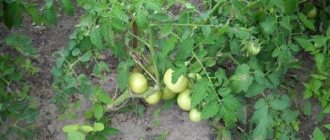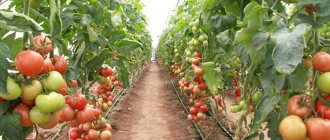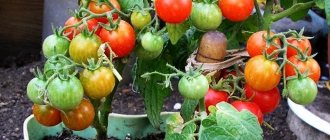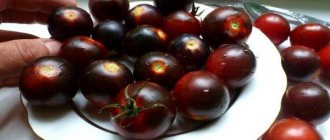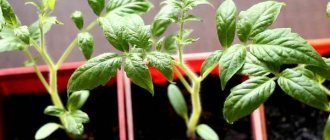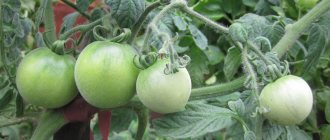Description of the tomato variety Lyrica with photo
Tomato Lyrica is a first generation hybrid (F1), bred by Russian breeder V. Blokin-Mechtalin. The variety was included in the register of achievements in 2022. Tomatoes can be grown in all regions, mainly under film covers or in greenhouses.
Main characteristics of the hybrid:
- determinate (does not grow after reaching a certain height);
- low-growing (the height of the Lyrica tomato bush is about 70-85 cm);
- early ripening (fruits are formed in 75-80, according to other sources, in 90-95 days).
The bush is very compact, which allows you to significantly save space in the garden and in greenhouses. The number of shoots and the degree of foliage are moderate. The branches are not too powerful, with pubescence. The leaves are medium sized, typical in shape, green in color. The surface is matte, slight wrinkles are noticeable.
The inflorescences are simple, the first of them grows above the 3rd or 5th leaf. Subsequently, flowering racemes appear through each leaf, and they are formed both from the axils and in the internodes. Each has quite a lot of yellow flowers, and the number of ovaries is 5-7. Almost all of them bear fruit.
Important! The Lyrica hybrid was obtained based on the genetic material of Lyubasha F1 tomatoes. From this variety, Lyrica inherited the attractive appearance of tomatoes and the rich composition of the juice, which includes trace elements and vitamins.
Description of fruits
The fruits are round in shape, flattened. They have thick, elastic skin. The surface is glossy, light red, without wrinkles. Slight ribbing is noticeable. Unripe Lyrica tomatoes are light green in color, without a dark spot at the stalk. The average weight of tomatoes, according to the register of breeding achievements, is about 140-150 g.
The pulp is red, fleshy and juicy, tender. The taste is very good - sweet tones and pleasant sourness are noticeable (more pronounced than its predecessor, the Lyubasha F1 tomato). The cut shows from 4 to 6 nests with seeds, which do not need to be collected. They will not be able to produce fertile offspring, since the Lyrica tomato is a hybrid, not a variety.
The average diameter of Lyrica tomatoes is 5-6 cm
Important! The lower shoots usually produce larger fruits, while the upper shoots usually produce smaller tomatoes. This is a normal feature for many varieties and hybrids, including Lyrica tomatoes.
Characteristics of tomato Lyrica
Tomato Lyrica is an early-ripening hybrid - the fruits are formed 3 months after germination. If you sow seeds for seedlings in mid-March, the first harvest can be harvested in the second half of June. At this point the tomatoes will be technically ripe. They can be removed from the bush and placed in a dark place or left to ripen on a branch.
Lyrica tomato yield and fruiting
According to various sources, up to 4-4.5 or 5-6 kg of Lyrica tomatoes can be harvested from 1 bush. The indicator largely depends on the method of cultivation, agricultural technology and weather conditions. Below are the average data.
| Growing method | In the greenhouse | In an open garden |
| From 1 bush, kg | 4-5 | 3-3,5 |
| From 1 m2, kg* | 16-20 | 12-15 |
*Since the bushes are very compact, at least 4 Lyrica tomatoes can be placed per 1 m2.
To achieve good yields, the crop is cultivated in greenhouse conditions, and they also monitor watering, regular fertilizing and other care rules:
- regular ventilation of the greenhouse;
- preventive treatment against diseases;
- tying to a support;
- forming a bush with 2 or 3 stems;
- removal of all stepsons up to the first flowering raceme.
Important! Sometimes gardeners form Lyric tomatoes into 4-5 stems. In this case, no more than 3 plants can be placed per 1 m2.
Area of application of fruits
Lyrica tomatoes have a very good taste, and they are also early, so the first salads with fresh tomatoes can be enjoyed at the end of June. The fruits are juicy - they are perfect for various dishes and preparations:
- sauces;
- soups;
- second courses;
- lecho;
- tomato juice;
- tomato puree;
- adjika.
Another advantage is the durable skin and small size of the tomatoes. Thanks to this, they are excellent for canning as a whole (salting, pickling).
Resistance to diseases and pests
Hybrid Lyrica has average immunity. Bushes rarely suffer from blossom end rot, but at the same time they are tolerant (low resistant) to diseases such as:
- tomato mosaic;
- Alternaria blight;
- late blight
Therefore, experienced summer residents recommend performing simple preventive actions:
- Treat seedlings with a fungicide a week before transplanting into the ground or immediately after.
- Moderate watering and ventilation of the greenhouse.
- Inspection of bushes and timely treatment against insects (insecticides, folk remedies).
Agricultural technology: manufacturer's recommendations
The described hybrid is not recommended to be planted by direct sowing of seeds into the soil. For early ripening, you need to plant pre-grown tomato seedlings. Seed preparation and seedling cultivation are carried out according to the standard scheme. Seedlings should be ready for transplanting in about 55 - 60 days. Calculate the sowing time taking into account the growing conditions. The recommended planting density is 4 pieces per 1 square meter in a greenhouse, and no more than 5 pieces per 1 square meter. meter on the street.
It is recommended to tie the plants to a support, otherwise the heavy ripening clusters may overhang and bend the stem. In a greenhouse, the variety can be formed into 3 - 4 stems, sometimes formation into 5 stems is allowed. In an open garden bed, Lyrica is formed into 2 - 3 stems so that the crop has time to fully ripen on the bush. Although it has been experimentally proven that even 4 stems (but only in warm regions) can produce wonderful results.
Stepping is carried out moderately or not at all. Further care for tomatoes is not difficult. Watering in the greenhouse and outside is carried out as the top layer of soil dries. In an open garden, natural precipitation must be taken into account. Fertilizers are applied mainly by universal ones, having a balanced composition. Weeding and loosening the soil after watering are also included in standard agricultural practices.
Lyrica is an excellent variety for an open garden bed or protected ground. The unusual thing about this variety is that in a greenhouse and in an open garden bed it always produces the same high yield. In protected soil, the yield can be higher by a little more than a kilogram, but tomatoes grown under real sun have better taste. Resistance to fungal and viral diseases will allow you to use garden chemicals less often, so the harvest can be environmentally friendly and truly beneficial to health. The fruits are equally good in their natural form and processed. No critical deficiencies were identified during cultivation. The only big disadvantage of the hybrid is the still high price of seed material and the need to constantly purchase seeds.
Advice from professionals
Seedlings should be watered when necessary: when the soil dries out. Tomatoes like moist soil, which means we water them 2 times/7 days, 2 times a day. When the fruits ripen, the bushes need more moisture, so we closely monitor this.
During cultivation, shoots are inspected and, if necessary, excess shoots are pruned. One bush should have 2-4 stems. Otherwise, the roots will interfere with each other, development will slow down, and the harvest will be small.
Plants require weeding and removal of weeds that steal nutrients from the fruit and infect them with diseases.
It is also necessary to pruning the stems. All excess shoots that do not bear fruit are removed. Stepchildren, if not controlled, can grow, and the yield will decrease because of this, because the main stem will not receive enough water and nutrients.
Grown plants require support. One bush can produce 20 kg of fruit, but the stems may not carry this and may break.
If the soil for growing tomatoes is infertile, then potassium and nitrogen can be added to the seedlings. You can mulch the soil in case of repeated frosts, just to be on the safe side. Mulch will be a good protector of seedlings from freezing and will retain water and nutrients.
Advantages and disadvantages
The Lyrica tomato has all the advantages of an early-ripening hybrid. It gives a good harvest and at the same time does not require special care. Any summer resident can cope with growing such a crop.
Lyrica F1 tomatoes ripen quickly on the branch
pros
- high productivity;
- good taste;
- keeping quality - does not lose its presentation for 3 weeks at a temperature of 2-10 degrees Celsius;
- transportability – can be transported over long distances;
- can be eaten fresh or seasoned;
- compact bushes save planting space;
- cultivation is allowed in all regions.
Minuses
- seeds cannot be collected independently - you have to buy them annually in stores or from suppliers;
- bushes need shaping and pinching;
- they need to be tied up;
- immunity is average - there is a risk of being affected by Alternaria, late blight and other diseases.
Care
Further care for tomatoes is not particularly difficult. It is necessary to continue regular irrigation and weeding. Also, as the crop grows, pinching is carried out - removing excess stems that are not intended for fruiting.
This will relieve the bush of unnecessary stress and direct nutrients to the ripening of the fruit. As the tomatoes grow, it is necessary to tie the stems onto trellises or string stretched vertically. This will increase the yield and prevent damage to the bush trunk.
Features of cultivation
Tomato Lyrica can be grown in 2 ways:
- Seedless - seeds are planted in the soil no earlier than mid-May (under film cover). In this case, the harvest can only be harvested in the first half of August.
- Seedling is a traditional option that allows you to get tomatoes at the end of June.
As a rule, summer residents choose the second option in order to take advantage of all the benefits of an early ripening hybrid. Seeds can be sown in mid-March (2 months before transplanting into open ground). The mixture can be purchased at the store or made from peat and garden soil (1:1) with a few pinches of sand and wood ash.
The seeds, previously disinfected in a 1% solution of potassium permanganate, are planted 1 cm deep, cover the containers with a film with holes and place them in a warm place (above 24 degrees). After the sprouts appear, the film is removed, and as 2-3 leaves form, the Lyrica tomato seedlings are transferred to separate cups. They are then grown at room temperature. A week before transplantation, they are hardened on the balcony or on the street.
Tomatoes ripen in clusters, so installation of a support is required
They are transferred to the ground in mid-May. The bushes are planted in a checkerboard pattern, leaving 50 cm between plants and 60 cm between rows. After transplantation, watering is carried out 2 times a week and fertilizing with complex fertilizer 2 times a month. Lyrica tomatoes must be tied up, shaped and planted, and the soil mulched. Weeding and loosening are carried out as necessary.
Landing rules
How to plant Lyrica F1 tomatoes? Agronomists do not recommend planting seeds in open soil; be sure to prepare seedlings! Ripening seedlings in a separate container with a nutrient substrate will avoid damage to plants from the negative influence of the external environment. Planting tomatoes in the warm season will not damage the stems from frost and will allow you to reap a good harvest.
A few basic rules for planting Lyric tomatoes:
- Four to five stems are planted per square meter. No more is needed - the plants will not have time to ripen, the root system will be cramped.
- Tomatoes are formed into four stems. If one of the stems has grown too early and has stopped growing, another one can be formed. Thus, up to twenty kilograms of tomatoes are harvested from one square.
- The tomato does not need to be tied up - up to six fruits ripen on a strong cluster, they rarely fall to the ground.
- The Lyric variety can also be grown in open soil without loss of yield. You can harvest only 1 kg less per square meter than with greenhouse planting. But tomatoes ripen faster in a greenhouse.
To protect against sudden temperature changes or when the soil is poor, you can fertilize the soil with special compounds. Whether or not to mulch the soil is the choice of the summer resident. A good productive hybrid will ripen under such conditions. But if you know that frost may strike, then it is better to lay paths between plantings with straw.
Pest and disease control
Preventive treatment of Lyric tomato with fungicides is carried out in early May, a few days before transplanting the seedlings. To prevent the development of fungal infections, you can use any proven drug:
- "Ordan";
- "Fitosporin";
- "Skor";
- "Maksim";
- "Fundazol".
Insects can be quickly destroyed using insecticides (especially in the initial stages of the invasion):
- "Decis";
- "Karbofos";
- "Spark";
- "Match";
- "Ephoria";
- "Fitoverm".
Folk remedies also help to cope with pests - a decoction of potato tops, an infusion of chopped garlic, chili pepper, a solution of soap shavings with wood ash and others.
Important! Treatment of Lyrica tomato bushes is carried out in dry weather, in the absence of strong wind, preferably in the evening. After using chemicals, it is important to start harvesting fruits no earlier than 2-3 days later.


